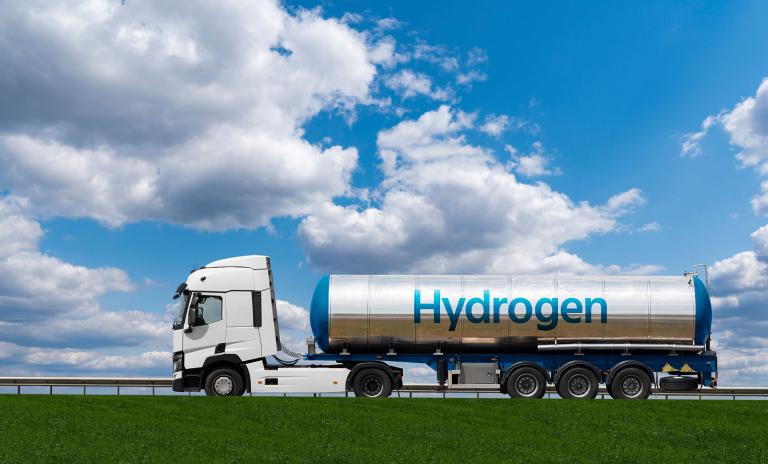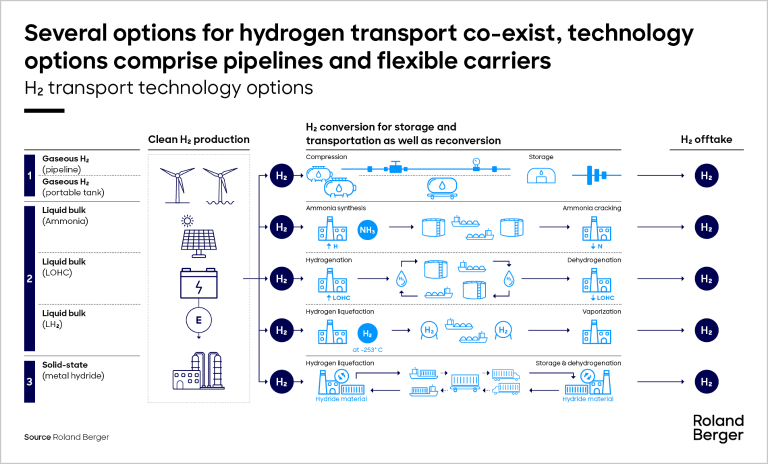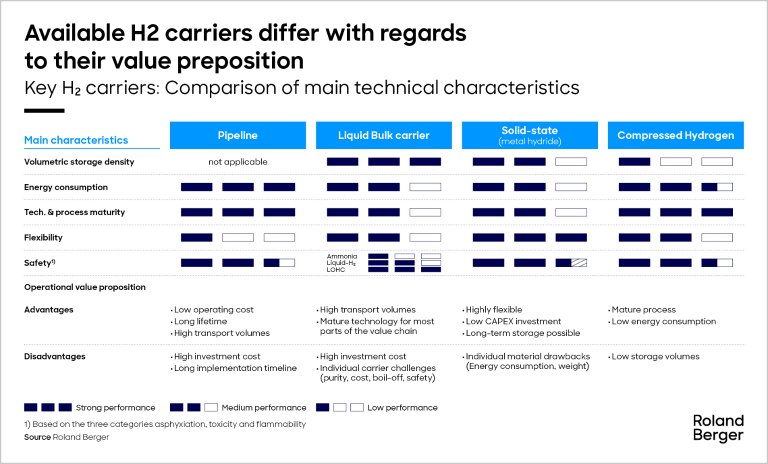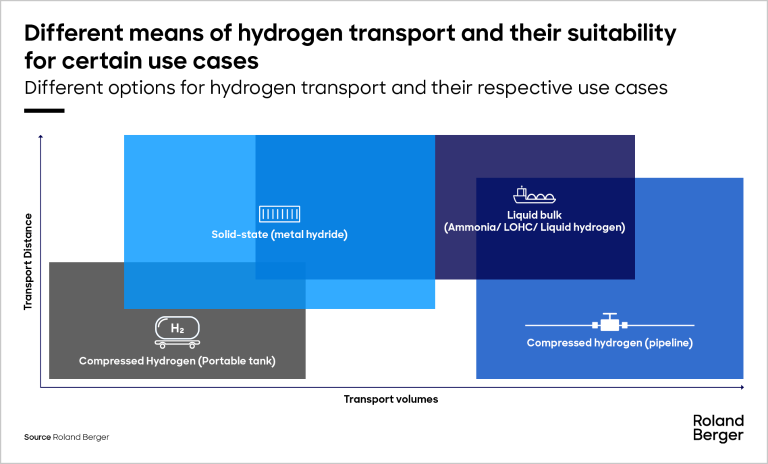Hydrogen is crucial for clean energy, but meeting the projected 2040 demand of 240 megatons annually requires a huge electrolyser capacity, far beyond current levels. The 2030s are key for the industry's growth, as highlighted in the study.


Is solid-state storage the missing ingredient in hydrogen transport?
Analyzing the complex challenges of hydrogen transport, including one newcomer with potential in the mid-volume segments
Clean hydrogen is one of the key pillars for decarbonization and achieving the 1.5-degree path outlined in the Paris Climate Agreement. For sectors that cannot be electrified, the versatile energy carrier and industry feedstock can help tackle critical challenges including the decarbonization of heavy industry and long-distance mobility.

However, hydrogen faces numerous challenges in becoming a widespread sustainable energy solution, with transport among the biggest. Hydrogen has a low ratio of energy per volume and is very reactive, which makes storage and transportation technically challenging and costly. Yet transportation is crucial for reducing the cost of hydrogen as an energy solution and ensuring a stable supply – particularly in regions grappling with scarcity of cost-effective local renewable energy such as Central Europe, Japan, or South Korea.
"Solid-state hydrogen storage offers a flexible solution for small- to mid-volume use cases with straightforward implementation and scalability."
Large-scale, long-distance solutions
Pipelines are currently one of the most common means of transporting energy. Their strengths include a long lifetime, low operating costs, and high transport volumes. These characteristics also make pipelines a promising choice for transporting hydrogen. What’s more, they can function as buffer storage by adapting pressure for fluctuating volumes and ensuring continuous supply – an essential requirement for major off-takers like fertilizer producers or steel plants.
Pipelines do have several drawbacks, however, especially the high up-front capital investment required. Approval and construction processes can also be lengthy and often need complex cross-border coordination. Repurposing natural gas pipelines for hydrogen transportation may offer potential cost savings, but concerns remain over material compatibility with older installments and, how to phase-over from legacy natural gas usage to hydrogen transport.
As a result, pipelines offer some promise for clean hydrogen transport in the future, but cannot be considered a widespread solution for the present. They are only expected to play a significant role once a certain market maturity and scale is reached.
Instead, large-scale, export-oriented hydrogen production projects are directing their attention to liquid bulk transport. This solution offers several options: hydrogen can be liquefied, as demonstrated in a first shipment between Australia and Japan in 2022; it can be converted to ammonia, as planned for the NEOM green hydrogen project in Saudi Arabia; or it can bonded to liquid organic hydrogen carriers (LOHC), as envisioned for imports to the port of Amsterdam.
Although a variety of technological solutions exists, the underlying principle is similar across all liquid bulk carriers: hydrogen undergoes an often energy-intensive process to achieve significantly higher volumetric density and reduced reactivity. This transformation enables transport with relatively compact and cost-effective tank units. Upon reaching their destination, carrier materials can either be directly employed in industrial applications, as is the case with ammonia, or converted back into hydrogen.
These solutions are typically based on proven chemical processes, but large-scale chemical equipment is needed to achieve acceptable unit costs. That’s not all: the dominant solution in the market, ammonia, must also overcome substantial safety challenges. Despite being globally handled at scale, securing regulatory approval for transporting ammonia through densely populated areas is uncertain. These limitations limit the use cases for liquid bulk carriers and hinder flexible scaling alongside the expected dynamic market development.
Solutions for small volumes and regional distribution
Large-volume, long-distance transport isn’t the only challenge hydrogen faces. Even low-volume use cases cannot rely on on-site hydrogen production due to reverse economies of scale and challenging regulations, particularly around the provision of green electricity.
For small-scale applications, the prevailing choice today is to compress gaseous hydrogen in portable tank units, which offer improved transport capacity, cost reduction, and energy consumption. Several applications, including hydrogen refueling stations, also require hydrogen in a compressed form for further processing, enabling seamless integration.
While off-takers value the minimal equipment needed to extract hydrogen from portable tank units, transporting compressed hydrogen at scale is challenging. Consequently, the emerging sector of mid-sized hydrogen projects, for off-grid clean energy supply or mid-scale industrial applications, e.g. in the glass industry, currently lacks fully suitable solutions.
Solid-state transport: the key to the mid-volume segment?
A range of technology companies across Europe and Asia now believe they have discovered the answer to this challenge – solid-state hydrogen storage. In this innovative process, hydrogen is bound to a metal hydride with moderate heat and pressure. The “hydrogenated” material can then be stored at ambient pressure and temperature without the risk of boil-off. To release hydrogen, the process is repeated with a different pressure and temperature range, enabling the extraction of hydrogen in its gaseous form. This rather simple conversion process significantly reduces the required investment.
As most hydride materials are reactive with either water or oxygen, providers currently package them in standard container units for transport and storage. Using this established infrastructure helps lower the investment costs for specialized equipment. Containers can also be seamlessly transferred between different modes of transport, a typical weakness of gaseous and liquid options, but often necessary in supply chains. Some manufacturers have already initiated approval procedures with European authorities to authorize this type of transport.
This progress has not happened overnight. The development of solid-state hydrogen dates back to the early 2000s but commercial applications have only recently emerged due to the challenge of finding the ideal material combination. Some materials are weighty, restricting the transport of hydrogen to small quantities relative to the carrier material needed. Lighter materials, however, still pose significant energy consumption hurdles – the majority of energy required is at the release point, where electricity costs are often higher and renewable power is scarce. Another open question, despite promising results from laboratory tests, is how durable the different material compositions will be in practice.
Outlook on hydrogen transport
Hydrogen transport remains a multifaceted challenge with no one-size-fits-all solution. While pipelines may become the primary method for large-volume transport, early applications demand different approaches.
The liquid bulk segment offers cost advantages, especially for long distances and substantial transport volumes; meanwhile, portable tanks for compressed hydrogen are likely to remain the standard choice for small-scale distribution, especially when hydrogen compression is needed for subsequent processes.
In scenarios characterized by rapid growth potential, but high initial uncertainty around volume uptake, solid-state hydrogen storage offers a solution with straightforward implementation, limited entry barriers in terms of infrastructure, and flexible scalability. The technology also integrates seamlessly into existing (multimodal) transport infrastructure and can help to unlock market segments by removing the barriers of high capital investments.
It seems likely that different hydrogen transport technologies will continue to co-exist in the market during the ramp-up and scaling phase, and likely also beyond. The optimal choice depends on concrete use cases, transport distance, and volumes. While not yet implemented at scale, solid-state storage enriches the market with a further solution option to the multi-faceted hydrogen transport challenge.









